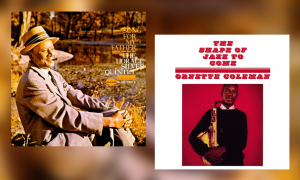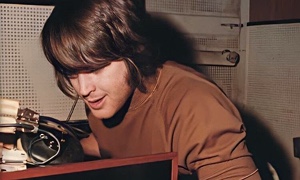Home » Jazz Articles » Building a Jazz Library » Mark Murphy: An Essential Top Ten Albums
Mark Murphy: An Essential Top Ten Albums
Nobody has any guts any more. Nobody rolls with the punches. That’s why I think you’ve got to keep a large part of yourself to yourself, and don’t let people fool around with it.
—Mark Murphy
What Murphy had in spades was creativity and hipness: he understood what jazz was. He would tell audiences that you can divide your life into two halves: Before Jazz and After Jazz. "You had a life before jazz," he said, "but once you heard jazz, you knew that your life would never be the same again." As a youngster he admired Peggy Lee and Nat King Cole, later hearing in Miles Davis' trumpet the kind of sounds he wanted to make with his voice. During the fifties he quickly became a master of swing, blues, latin and ballads, but even as he began his recording career, Mark Murphy had little idea what sort of jazz singer he was. Two commercially unsuccessful albums with Decca were followed by three equally unsuccessful Capitol releases: these mainstream labels had no more idea how to handle Murphy's uniquely hip take on his craft than he did. It wasn't until he joined jazz specialist label Riverside that he found a more congenial home and began to evolve into the singer he ultimately became.
Singing live, Murphy was a consummate improviser who challenged his accompanists to be as brave and spontaneous as he was. His communication with musicians was telepathic. When he introduced a song he often took the trouble to tell the audience who had written it and in what circumstances; who had recorded it, and what it was really about. Some of his interpretations were eccentric, to say the least: he was convinced that Antonio Carlos Jobim's "The Waters of March" was a deconstructed murder story. For a while his vocal gymnastics became equally unconventional —even tiresome. The sudden swoops, the alarming falsetto passages, the strange yelps and yaps were not to everyone's taste. But when he swung, he swung like a bebop master. And when he sang ballads, the room would become hushed, as Murphy wrung every drop of heartache and loss from the melody. During performances he would also tell jokes, act the clown, and read out poetry and prose.
Jazz singers are often considered semi-detached from the jazz tradition, a decorative bolt-on to the real action, which is instrumental. It is also unavoidably true that many singers lack the musical chops to talk the language of jazz, let alone sing it. But Mark Murphy had chops to spare, and played his voice like an instrument. Today, his reputation among those who know about him could hardly be higher. But as I discovered when I wrote my biography This is Hip: the Life of Mark Murphy (Equinox, 2018), very little was written about him during his lifetime. He seemed to have been a permanently underground phenomenon, known only to a small but devoted band of cognoscenti. Yet we do still have the albums.
Those listed below are, of course, not a definitive Murphy Top Ten; everyone will have their own favourites. However the choices do represent Murphy at his best across a wide range of material, ancient and modern. Anyone serious about building a library of jazz singers would do well to start here.
 That's How I Love The Blues!
That's How I Love The Blues!Riverside, 1963
After a couple of contributions to the Riverside sampler album Everybody's Doin' the Bossa Nova and the release of his own well- received LP Rah (which he himself did not rate very highly), Mark Murphy finally hit his stride with That's How I Love The Blues!. It's no accident that the opening track—"Goin' to Chicago Blues"—is a Count Basie tune with lyrics by Jimmy Rushing: Murphy knew by now that he was a rhythm singer, who was alive to all the possibilities of syncopation and incorporated them into his vocal delivery. This album is not faux-country blues, nor a raucous imitation of the electric Chicago style, but sophisticated big city jazz-blues in the Billy Eckstine tradition. "Señor Blues" is a rhythmically strong Horace Silver tune with an undulating 12/8 Afro-Cuban beat, and it became a staple of Murphy's live performances. Here he delivers an intimate, confidential vocal, underpinned by a doubled bass/piano ostinato, with an all-brass instrumental line-up that includes Snooky Young and Clark Terry, along with Roger Kellaway on piano. There's a pleasing lightness of touch here, and Al Cohn's arrangements are particularly sensitive to the quality of Murphy's voice, which sounds relaxed and soulful throughout. That's How I Love The Blues! turned out to be his last American album for almost a decade.
 Midnight Mood
Midnight Mood SABA, 1968
By the time he recorded Midnight Mood in Köln in December 1967, Murphy had been living in London for four years. Here his collaborators are musicians (and composers) he had come to know through numerous Ronnie Scott's residencies and tours. All were members of the Kenny Clarke-Francy Boland Big Band, including Ronnie Scott, Jimmy Deuchar, Sahib Shihab and Jimmy Woode. "Why and How" is a soul-jazz rare groove number beloved of DJ Gilles Peterson, who turned it into an unlikely dancefloor smash in the 1980s. The groovy backbeat, complete with cowbell, plus the great horn backings, speaks of the Swinging Sixties, and no one was more swinging than Mark Murphy. On "My Ship" he sounds warm and relaxed, with some well-judged glissando. This was the kind of material he loved and knew well. He used to say his true voice didn't emerge until he was 40, i.e. at around the time he went back to the US. But that voice is already here.
 Bridging a Gap
Bridging a Gap Muse, 1973
Returning to the States after a decade in Europe, Murphy soon impressed Muse Records owner Joe Fields, who offered him a deal that was renewed frequently over the years that followed. Murphy's musical outlook had by now broadened to encompass pop, rock, folk and latin styles. Bridging a Gap also sees the emergence of a style we might call Mark Murphy Gothic, with two examples on this album. The first is "Come and Get Me," a composition of his own that he had previously recorded for Riverside in 1962. Here it's a spooky, prowling arrangement featuring Pat Rebillot's Hammond organ. There's more Gothic on the Jimmy Dorsey standard "I'm Glad There is You," with which Murphy takes some bold liberties. On the long verse intro to this partially reharmonized version, he is backed only by Sam Brown's reverberating guitar. The rest of the band comes in halfway through the verse, with ominously gurgling organ and a passionate vocal from Murphy. The tune fades out slowly, with a dark, Phrygian mode guitar solo over ghostly midnight chords. Is it jazz? Is it rock? Who cares—it's wonderful.
 Mark Murphy Sings
Mark Murphy Sings Muse, 1975
Mark Murphy's career was strewn with banana skins. One of them was the often terrible album covers, of which this was perhaps the worst, depicting what looks like a Marigold rubber glove in an abstract landscape. It effectively masks one of the greatest jazz vocal albums in history. Mark Murphy Sings continues his fruitful partnership with producer-arranger Dave Matthews, which this time brought forth such timeless classics as his lyricized version of Freddie Hubbard's "Red Clay," featuring David Sanborn, Michael Brecker and Randy Brecker. The John Coltrane ballad "Naima" is another of Murphy's Gothic spine-chillers, with ominous Don Grolnick organ and blaring horns, but the killer is Sanborn's alto saxophone, piping like an ancient ram's horn. Murphy wrote the lyrics, and his voice captures something timeless and incantatory about the tune, whose original sounds almost tame compared to this. Milton Nascimento's "Empty Faces" (originally "Vera Cruz"), powered by Harvie S's driving electric bass and Sue Evans's percussion, became another dancefloor smash in 1980s London.
 Stolen Moments
Stolen Moments Muse, 1978
The title track to this album became Mark Murphy's signature tune, and it was played constantly on American jazz radio at the time. He had written the lyrics to Oliver Nelson's standard years earlier, but had only recently started performing it in clubs. The vocal version proved an inspiration to those jazz singers who chafed against the straightjacket of the Great American Songbook and longed to contribute their own words to instrumentals. Annie Ross, a pioneer in this field, wrote the bonkers vocalese lyrics to "Farmer's Market," but Mark Murphy, on this album, was the one who really nailed the vocal, rendering Ross's tongue-twisters effortlessly despite the suicidal tempo. Stolen Moments also marked his first collaboration with alto saxophonist Richie Cole, whose work with the singer Eddie Jefferson he admired.
 Bop for Kerouac
Bop for Kerouac Muse, 1981
If Mark Murphy was the ultimate hipster in song, his prose equivalent was beatnik author Jack Kerouac. Murphy felt great affinity for this chronicler of the bebop era, even reading passages from his books at gigs. And he recorded a couple of those readings for Bop for Kerouac, the first of two album-length homages to the writer. Arranged by pianist Bill Mays, it features Richie Cole and guitarist Bruce Forman. The album also served as a counter-blast to the newly-elected Ronald Reagan's mom-and-apple-pie agenda. But Bop for Kerouac is not the wild scat-fest it could have been. Instead the mood is elegiac, and ballads dominate— notably "Ballad of the Sad Young Men." From a lyricized version of Charlie Parker's "Boplicity," here re-titled "Bebop Lives," to Joni Mitchell's words for "Goodbye Pork Pie Hat," Murphy cooks up a satisfying mélange of sadness and euphoria.
 Living Room
Living Room Muse, 1986
Although Living Room is not one of the better-known Mark Murphy albums, it is one of the hippest things he ever recorded. Opening with the title track, he demonstrates yet again how good he is at simply riding the beat and inserting syncopations of his own. This sleek, finger-snappin' Abbey Lincoln/Max Roach tune showcases David Braham's organ, with fills from Gerry Niewood's tenor, and cool solos from each, enlivened by Larry Killian's congas. Murphy produced the album along with Braham, who plays the bass part too, and the legendary Grady Tate is on drums. The singer continues his tradition of including a comedy tune on each album. Not all of them came off, but his take on "Ain't Nobody Here But Us Chickens" is a delight, complete with clucks, and chicken and lightbulb jokes. But it was another duff album sleeve, featuring a slightly out of focus photo taken by Murphy's long-term partner Eddie O'Sullivan. Someone also thought it was a good idea to release the disc on green translucent vinyl.
 Kerouac Then and Now
Kerouac Then and Now Muse, 1989
Murphy's second tribute to Jack Kerouac was one of his best ever albums, perfectly realised and performed by all concerned, particularly Bill Mays. There's another slice of Murphy Gothic in the ultra-slow "Blood Count," the tune Billy Strayhorn wrote in 1967 while dying from oesophageal cancer. The lyrics had been added recently by M.B. Stillman. It starts with Murphy's high foghorn notes and a few glittering runs from Mays, also some realistic-sounding harp and string ensemble effects, and latterly some gothic descending organ, as Murphy sings Come and meet me in a dream. The whole album is haunted by death, since Murphy's partner Eddie was also dying at the time. Another poignant highlight is the medley of "The Night We Called It A Day" and "There's No You."
 The Dream
The Dream Jive, 1995
Although he never made an American album with strings, Murphy visited the Netherlands regularly between 1969 and 1993, recording a few songs with the Dutch Metropol Orkest for radio broadcast on each visit. The best were compiled for this Austrian release. Among the extremely broad selection is the Buddy Johnson r&b ballad "Since I Fell for You." Murphy's version was arranged by Rob Pronk, who gives it a soft, romantic treatment. Murphy always went to the trouble of restoring forgotten verses to songs, and this one is a cracker, delaying the start of the tune proper until it finally hits its 12/8 stride. The piano tinkles on a bed of strings, and Murphy repeats the sad lines For those who give love, and never get love... on the fade. Other tracks include the Sergio Mendes tune "So Many Stars," Lalo Schifrin's "Down Here on the Ground" and Stevie Wonder's "All in Love is Fair."
 Once to Every Heart
Once to Every Heart Verve, 2005
German trumpet star Till Bronner became a serious fan of Mark Murphy after hearing him play at the A-Trane in Berlin. Brönner persuaded him to record an album of ballads with only himself and pianist Frank Chastenier as accompanists, later adding a full orchestra arranged by Nan Schwartz, a protégé of Johnny Mandel. Recorded in 2002, Once to Every Heart had to wait three years for release until Murphy's Muse contract expired. His voice now having acquired a gnarled and leathery maturity, the album captures him in his autumnal prime. On "Skylark," the line Where someone's waiting to be kissed is immediately followed by Brönner's tremulous breathy note, like a tongue fluttering in your ear. The sepulchral "Our Game" begins with a flamenco-like flourish and Brönner plays a full chorus before Murphy begins to sing. From then until the coda, its delicate, shimmering strings and faintly warbling flutes cast an unforgettable spell.
Tags
Building a Jazz Library
Mark Murphy
Peter Jones
Peggy Lee
Nat King Cole
Miles Davis
Count Basie
Jimmy Rushing
Billy Eckstine
Horace Silver
Snooky Young
Clark Terry
Roger Kellaway
Al Cohn
Kenny Clarke-Francy Boland Big Band
Ronnie Scott
Jimmy Deuchar
Sahib Shihab
Jimmy Woode
Pat Rebillot
Jimmy Dorsey
Sam Brown
Dave Matthews
Freddie Hubbard
David Sanborn
Michael Brecker
randy brecker
John Coltrane
Don Grolnick
Milton Nascimento
Harvie S
Sue Evans
Oliver Nelson
Annie Ross
Richie Cole
Eddie Jefferson
Bill Mays
bruce forman
Charlie Parker
Joni Mitchell
David Braham
Gerry Niewood
Larry Killian
Grady Tate
Billy Strayhorn
Dutch Metropol Orkest
Buddy Johnson
Rob Pronk
Sergio Mendes
Lalo Schifrin
Stevie Wonder
Till Bronner
Frank Chastenier
Nan Schwartz
Johnny Mandel
PREVIOUS / NEXT
Support All About Jazz
 All About Jazz has been a pillar of jazz since 1995, championing it as an art form and, more importantly, supporting the musicians who make it. Our enduring commitment has made "AAJ" one of the most culturally important websites of its kind, read by hundreds of thousands of fans, musicians and industry figures every month.
All About Jazz has been a pillar of jazz since 1995, championing it as an art form and, more importantly, supporting the musicians who make it. Our enduring commitment has made "AAJ" one of the most culturally important websites of its kind, read by hundreds of thousands of fans, musicians and industry figures every month.























